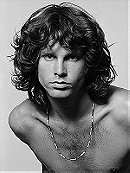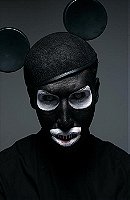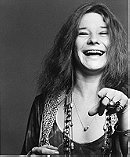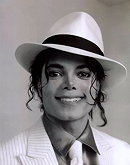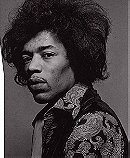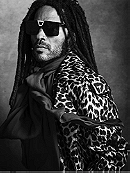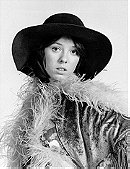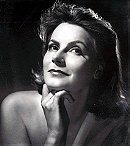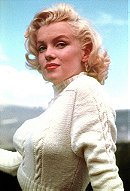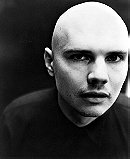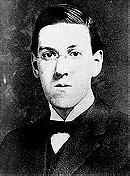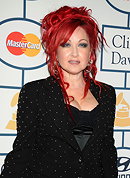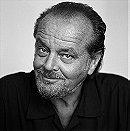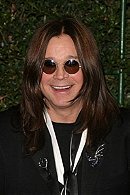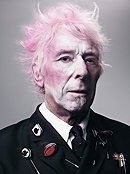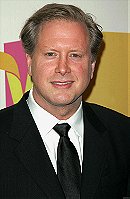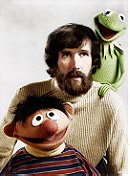Benefits of having a fucked up childhood.
Sort by:
Showing 38 items
Rating:
List Type:

When Rose was two years old, his father abandoned the family. His mother remarried to Stephen L. Bailey, and changed Axl's name to William Bruce Bailey. He has two younger siblings—a sister, Amy, and a half-brother, Stuart. Until the age of 17, Rose believed that Bailey was his natural father. He never met his biological father as an adult; William Rose, Sr. was found murdered in Illinois in 1984.
The Bailey household was very religious; Rose and his family attended a Pentecostal church, where he was required to attend services three to eight times per week and even taught Sunday school. Rose later described his upbringing as oppressive, stating, "We'd have televisions one week, then my stepdad would throw them out because they were satanic. I wasn't allowed to listen to music. Women were evil. Everything was evil." In 1992, after undergoing past life regression therapy, Rose claimed he had uncovered memories of being sexually abused by his biological father at the age of two. He also stated that his stepfather had physically abused him and his siblings, as well as sexually abused his sister. Rose found solace in music from an early age. He sang in the church choir from the age of five, and performed at services with his brother and sister under the name the Bailey Trio. At Jefferson High School, he participated in the school chorus and studied piano. A second baritone, Rose began developing "different voices" during chorus practice to confuse his teacher. He eventually formed a band with his friends, one of whom was Jeff Isbell, later known as Izzy Stradlin.
At the age of 17, while going through insurance papers in his parents' home, Rose learned of his biological father's existence, and he unofficially readopted his birth name. However, he referred to himself only as W. Rose, because he did not want to share a first name with his biological father. (Four years later, after moving to Los Angeles, he became so engrossed in his band AXL that his friends suggested he call himself Axl Rose; he legally changed his name to W. Axl Rose prior to signing his contract with Geffen Records in March 1986.) Following the discovery of his true family origins, Rose became the local juvenile delinquent in Lafayette; he was arrested over 20 times on charges such as public intoxication and battery, and served jail terms up to three months. After Lafayette authorities threatened to charge him as a habitual criminal, Rose moved to Los Angeles, California in December 1982.

When Cobain was seven years old, his parents divorced.[16] Later in his life, he said the divorce had a profound effect on his life. His mother noted that his personality changed dramatically; Cobain became defiant and withdrawn.[17] In a 1993 interview, he elaborated:
"I remember feeling ashamed, for some reason. I was ashamed of my parents. I couldn't face some of my friends at school anymore, because I desperately wanted to have the classic, you know, typical family. Mother, father. I wanted that security, so I resented my parents for quite a few years because of that."[18]
Cobain's parents both found new partners after the divorce. His father had promised not to remarry; however, after meeting Jenny Westeby, he did, to Kurt's dismay.[19] Kurt, his father, Westeby, and her two children Mindy and James, moved into a new household together. Cobain liked Westeby at first, who gave him the maternal attention he desired.[

Morrison's early life was a nomadic existence typical of military families.[36] Jerry Hopkins recorded Morrison's brother, Andy, explaining that his parents had determined never to use physical corporal punishment such as spanking on their children. They instead instilled discipline and levied punishment by the military tradition known as dressing down. This consisted of yelling at and berating the children until they were reduced to tears and acknowledged their failings. Once Morrison graduated from UCLA, he broke off most contact with his family. By the time Morrison's music ascended to the top of the charts (in 1967) he had not been in communication with his family for more than a year and falsely claimed that his parents and siblings were dead (or claiming, as it has been widely misreported, that he was an only child). In 1947, Morrison, then four years old, allegedly witnessed a car accident in the desert, in which a family of Native Americans were injured and possibly killed. He referred to this incident in a spoken word performance on the song "Dawn's Highway" from the album An American Prayer, and again in the songs "Peace Frog" and "Ghost Song". Morrison believed this incident to be the most formative event of his life,[10] and made repeated references to it in the imagery in his songs, poems, and interviews. His family does not recall this incident happening in the way he told it. According to the Morrison biography No One Here Gets Out Alive, Morrison's family did drive past a car accident on an Indian reservation when he was a child, and he was very upset by it. The book The Doors, written by the remaining members of The Doors, explains how different Morrison's account of the incident was from that of his father. This book quotes his father as saying, "We went by several Indians. It did make an impression on him [the young James].

His biological father was a drunk who physically abused him and his step-dad was a religious dick. Wikipedia wasn't very helpful this time.

Hetfield was born August 3, 1963.[2] He is of German, English, Irish and Scottish descent. He has two older half-brothers from his mother's first marriage and one younger sister. He attended Downey High School his freshman and sophomore years. He graduated from Orange County's Brea Olinda High School in 1981.[3]
His father, Virgil, was a truck driver. His mother, Cynthia, was a light opera singer. The two divorced in 1976 when Hetfield was young. Virgil and Cynthia were very strict Christian Scientists, and in accordance with their beliefs, Hetfield's parents strongly disapproved of medicine or any other medical treatment and remained loyal to their faith even as Cynthia was dying from cancer. This upbringing became the inspiration for many of Hetfield's lyrics later in his career with Metallica, such as songs like "The God That Failed".
Cynthia Hetfield died of cancer in 1979 when James was 16 years old. After the death of his mother, Hetfield went to live with his older half-brother David. Virgil died in late 1996, during Metallica's Load tour.[4]

Marilyn Manson was born in Canton, Ohio. He is the only son of Barbara Warner (maiden name Wyer) and Hugh Warner.[5] Manson is of German and Polish descent on his father's side,[6] and is a fourth cousin twice removed of Conservative commentator Pat Buchanan.[5][7] In his autobiography The Long Hard Road Out of Hell, he detailed his grandfather's sexual fetishes (including bestiality and sadomasochism) which led to the forming of Marilyn Manson and the Spooky Kids. As a child, he attended his mother's Episcopal church, though his father was a Catholic.

Janis Joplin was born in Port Arthur, Texas, on January 19, 1943,[2] to Dorothy (née East) Joplin (1913–1998), a registrar at a business college, and her husband, Seth Joplin (1910–1987), an engineer at Texaco. She had two younger siblings, Michael and Laura. The family attended the Church of Christ.[3] The Joplins felt that Janis always needed more attention than their other children, with her mother stating, "She was unhappy and unsatisfied without [receiving a lot of attention]. The normal rapport wasn't adequate."[4] As a teenager, she befriended a group of outcasts, one of whom had albums by African-American blues artists Bessie Smith, Ma Rainey and Lead Belly, whom Joplin later credited with influencing her decision to become a singer.[5] She began singing in the local choir and expanded her listening to blues singers such as Odetta, Billie Holiday and Big Mama Thornton.
Primarily a painter while still in school, she first began singing blues and folk music with friends. While at Thomas Jefferson High School, she stated that she was mostly shunned.[5] Joplin was quoted as saying, "I was a misfit. I read, I painted, I didn't hate niggers."[4] As a teen, she became overweight and her skin broke out so badly she was left with deep scars which required dermabrasion.[4][6][7] Other kids at high school would routinely taunt her and call her names like "pig", "freak" or "creep".[4] Among her classmates were G. W. Bailey and Jimmy Johnson. Joplin graduated from high school in 1960 and attended Lamar State College of Technology in Beaumont, Texas, during the summer[6] and later the University of Texas at Austin, though she did not complete her studies.[8] The campus newspaper The Daily Texan ran a profile of her in the issue dated July 27, 1962, headlined "She Dares to Be Different".[8] The article began, "She goes barefooted when she feels like it, wears Levi's to class because they're more comfortable, and carries her Autoharp with her everywhere she goes so that in case she gets the urge to break into song it will be handy. Her name is Janis Joplin."[8]

ackson had a troubled relationship with his father, Joe.[16][17][18] Joseph acknowledged in 2003 that he regularly whipped Jackson as a boy.[18] Jackson stated that he was physically and emotionally abused during incessant rehearsals, though he also credited his father's strict discipline with playing a large role in his success.[16] Jackson first spoke openly about his childhood abuse in an interview with Oprah Winfrey, broadcast in February 1993. He admitted that he had often cried from loneliness and he would vomit on the sight of his father. Jackson's father was also said to have verbally abused Jackson, saying that he had a fat nose on numerous occasions.[19] In fact, Michael Jackson's deep dissatisfaction with his appearance, his nightmares and chronic sleep problems, his tendency to remain hyper-compliant especially with his father, and to remain childlike throughout his adult life are in many ways consistent with the effects of this chronic maltreatment he endured as a young child.[20]

In 1941, Al met Lucille Jeter (1925–1958) at a dance in Seattle; they married on March 31, 1942.[6] Drafted into the United States Army to serve in World War II, Al went to war three days after their wedding.[7] The first of Lucile's five children, Johnny Allen Hendrix was born November 27, 1942 in Seattle, Washington. In 1946, due to being unable to consult his father Al at the time of birth, his parents changed Johnny's name to James Marshall Hendrix, in honor of Al and Al's late brother Leon Marshall.[8][nb 2][nb 3]
Stationed in Alabama at the time of Johnny's birth, Al was denied the standard military furlough afforded servicemen for childbirth and placed by his commanding officer in the stockade to prevent his going AWOL to see his infant son in Seattle. He spent two months locked up without trial, and while in the stockade, received a telegram announcing his son's birth.[10][nb 4] During Al's three-year absence, Lucille struggled to raise their son, often neglecting him in favor of nightlife.[12] During this period he was mostly cared for by family members and friends, especially Lucille's sister Delores Hall and her friend Dorothy Harding.[13][14] Al received an honorable discharge from the U.S. Army on September 1, 1945. Two months later, unable to find Lucille, Al went to the Berkeley home of a family friend named Mrs. Champ, who had taken care of and had attempted to adopt Jimi, and saw his son for the first time.[15][16]
After returning from service Al reunited with Lucille, but his difficulty finding steady work left the family impoverished. Both he and Lucille struggled with alcohol abuse, and they often fought when intoxicated. His parents' violence sometimes made Hendrix withdraw and hide in a closet in their home.[17] Jimi's relationship with his brother Leon (born 1948) was close but precarious; with Leon in and out of foster care, they lived with an almost constant threat of fraternal separation.[18] In addition to Leon, Jimi had three other younger siblings: Joseph, born in 1949, Kathy in 1950, and Pamela, 1951, all of whom Al and Lucille gave up to foster care and adoption.[19] The family frequently moved, staying in cheap hotels and apartments around Seattle. On occasion, family would take Hendrix to Vancouver to stay at his grandmother's. A shy and sensitive boy, Hendrix was deeply affected by these experiences.[20] In later years, he confided to a girlfriend that he had been the victim of sexual abuse by a man in uniform.[21]
On December 17, 1951, when Hendrix was nine years old, his parents divorced; the court granted Al custody of Jimi and Leon.[22] At thirty-three, Lucille had developed cirrhosis of the liver; she died on February 2, 1958 when her spleen ruptured.[23] Instead of taking Jimi and Leon to attend their mother's funeral, Al gave them shots of whiskey and told them that was how men are supposed to deal with loss.[23][nb 5]

In September 2009, Phillips' memoir High on Arrival was released, after which she appeared on The Oprah Winfrey Show for an hour-long interview. She told Winfrey that she first tried cocaine when she was 11 years old, and that her father did drugs with her and injected her with cocaine.
During the interview, Phillips read excerpts from her book. She said that at the age of 19, on the night before her first wedding, "I woke up that night from a blackout to find myself having sex with my own father." In a later article in People magazine, she adds that she was under the influence of drugs provided by her father.[9] Phillips then told Winfrey, "It became a consensual relationship,"[10][11] describing her participation as "sort of Stockholm Syndrome, where you begin to love your captor."[11] She later reconsidered her characterization that it was a consensual relationship. In an interview on HLN's The Joy Behar Show, she said: "As I was writing the book, I thought, this word, it kept sitting wrong with me. But I used it for lack of a better word. Since then, I've been schooled by thousands of incest survivors all across the world that there really is no such thing as consensual incest due to the inherent power a parent has over a child. So, I wouldn't necessarily call it a consensual relationship at this time."[12]
Phillips said the incestuous relationship had happened gradually for ten years,[13] and that she ended it when she became pregnant and did not know who had fathered the child. She stated that her father paid for her to have an abortion, "and I never let him touch me again."[14][15]
Genevieve Waite, John's wife at the time MacKenzie claimed the incest first began, denies the allegations, saying they were inconsistent with his character. Michelle Phillips, John's second wife, also stated that she had "every reason to believe [Mackenzie's account is] untrue."[16]
Chynna Phillips, Mackenzie's half-sister and Michelle Phillips' daughter, stated that she believed Mackenzie's claims and that Mackenzie first told her about the relationship during a phone conversation in 1997, approximately 11 years after the supposed relationship had ended.[17] Bijou Phillips, Mackenzie's other half-sister, said in a statement that Mackenzie had informed her of the relationship when Bijou was 13 years old,[18] but also stated, "I'm 29 now, I've talked to everyone who was around during that time, I've asked the hard questions. I do not believe my sister. Our father is many things; this is not one of them."[19] Jessica Woods, daughter of Denny Doherty, said that her father knew of the relationship.[20]

Greta Lovisa Gustafsson was born in Stockholm, Sweden. She was the third and youngest child of Anna Lovisa (née Karlsson, 1872–1944)—a homemaker who later worked at a jam factory—and Karl Alfred Gustafsson (1871–1920), a laborer.[2][3] Garbo had an older brother, Sven Alfred (1898–1967), and an older sister, Alva Maria (1903–1926).[4]
Her parents met in Stockholm where her father visited from Frinnaryd. He moved to Stockholm to become independent and worked in various odd jobs—street cleaner, grocer, factory worker and butcher's assistant.[5] He married Anna, who had recently relocated from Högsby.[6][7] The Gustafssons were impoverished and lived in a three-bedroom cold-water flat at Blekingegatan No. 32. They raised their three children in a working-class district regarded as the city's slum.[8] Garbo would later recall:
It was eternally gray—those long winter's nights. My father would be sitting in a corner, scribbling figures on a newspaper. On the other side of the room my mother is repairing ragged old clothes, sighing. We children would be talking in very low voices, or just sitting silently. We were filled with anxiety, as if there were danger in the air. Such evenings are unforgettable for a sensitive girl. Where we lived, all the houses and apartments looked alike, their ugliness matched by everything surrounding us.[9]
Garbo was a shy daydreamer as a child.[10] She hated school[11][12] and preferred to play alone.[13] Yet she was an imaginative child and a natural leader[14] who became interested in theatre at an early age.[15] She directed her friends in make-believe games and performances[16] and dreamed of becoming an actress.[15][17] Later, she would participate in amateur theatre with her friends and frequent the Mosebacke Theater.[18] At the age of 13, Garbo graduated from school,[19] and, typical of a Swedish working-class girl at that time, she did not attend high school. She would later confess she had an inferiority complex about this.[20]
In the winter of 1919, the Spanish flu spread throughout Stockholm, and Garbo's father, to whom she was very close, became ill. He began missing work and eventually lost his job.[21] Garbo stayed at home looking after him and taking him to the hospital for weekly treatments. He died in 1920 when she was 14 years old.[7][22]

In the wake of this sudden stardom, Barrymore endured a notoriously troubled childhood. She was already a regular at the famed Studio 54 when she was a little girl, smoking cigarettes at age nine, drinking alcohol by the time she was 11, smoking marijuana at 12, and snorting cocaine at 13.[1][3] Her nightlife and constant partying became a popular subject with the media.[1] She was in rehab at age 14.[1][3] A suicide attempt at age 14 put her back in rehab, followed by a three-month stay with singer David Crosby and his wife.[9] The stay was precipitated, Crosby said, because she "needed to be around some people that were committed to sobriety."[9] Barrymore later described this period of her life in her autobiography, Little Girl Lost. The next year, following a successful juvenile court petition for emancipation, she moved into her own apartment.[9]
Aaron M.'s rating:



Her parents split up shortly after her birth.This left her with a rocky relationship with her father,also they used to fight in front of her. She has two half-siblings (Alisa and Kyle) from her father's remarriage.Wikipedia again wasn't very helpful.
Aaron M.'s rating:



Born into a poor family in Mississippi, Hawkins lived a difficult early life, ending up at a reform school by age 12, and drifting, hitching, and stealing his way across the country for the next dozen years, earning several stays in prison including a three-year stint for stealing a leather jacket as a teenager. Along the way, he picked up a love of music and a talent for the guitar. "I was sent to a school for bad boys called Oakley Training School in 1949", he wrote in a brief piece of autobiography . "There I developed my voice by singing with a group that the superintendent's wife had got together". After reform school, he ended up in the state penitentiary and was released at 19.

Wikipedia was actually really helpful this time.
Marilyn Monroe was born on June 1, 1926, in the Los Angeles County Hospital[11] as Norma Jeane Mortenson (soon after changed to Baker), the third child born to Gladys Pearl Baker (née Monroe, May 27, 1902 – March 11, 1984).[12] Monroe's birth certificate names the father as Martin Edward Mortensen with his residence stated as "unknown".[13] The name Mortenson is listed as her surname on the birth certificate, although Gladys immediately had it changed to Baker, the surname of her first husband and which she still used. Martin's surname was misspelled on the birth certificate leading to more confusion on who her actual father was. Gladys Baker had married a Martin E. Mortensen in 1924, but they had separated before Gladys' pregnancy.[14] Several of Monroe's biographers suggest that Gladys Baker used his name to avoid the stigma of illegitimacy.[15] Mortensen died at the age of 85, and Monroe's birth certificate, together with her parents' marriage and divorce documents, were discovered. The documents showed that Mortensen filed for divorce from Gladys on March 5, 1927, and it was finalized on October 15, 1928.[16][17] Throughout her life, Marilyn Monroe denied that Mortensen was her father.[14] She said that, when she was a child, she had been shown a photograph of a man that Gladys identified as her father, Charles Stanley Gifford. She remembered that he had a thin mustache and somewhat resembled Clark Gable, and that she had amused herself by pretending that Gable was her father.[14][18]
Gladys was mentally unstable and financially unable to care for the young Norma Jeane, so she placed her with foster parents Albert and Ida Bolender of Hawthorne, California, where she lived until she was seven. One day, Gladys visited and demanded that the Bolenders return Norma Jeane to her. Ida refused, as she knew Gladys was unstable and the situation would not benefit her young daughter. Gladys pulled Ida into the yard, then quickly ran back to the house and locked herself in. Several minutes later, she walked out with one of Albert Bolender's military duffel bags. To Ida's horror, Gladys had stuffed a screaming Norma Jeane into the bag, zipped it up, and was carrying it right out with her. Ida charged toward her, and their struggle split the bag apart, dumping out Norma Jeane, who wept loudly as Ida grabbed her and pulled her back inside the house, away from Gladys.[19] In 1933, Gladys bought a house and brought Norma Jeane to live with her. A few months later, Gladys began a series of mental episodes that would plague her for the rest of her life. In My Story, Monroe recalls her mother "screaming and laughing" as she was forcibly removed to the State Hospital in Norwalk.
Norma Jeane was declared a ward of the state. Gladys's best friend, Grace McKee, became her guardian. It was Grace who told Monroe that someday she would become a movie star. Grace was captivated by Jean Harlow, and would let Norma Jeane wear makeup and take her out to get her hair curled. They would go to the movies together, forming the basis for Norma Jeane's fascination with the cinema and the stars on screen. When Norma Jeane was 9, McKee married Ervin Silliman "Doc" Goddard in 1935, and subsequently sent Monroe to the Los Angeles Orphans Home (later renamed Hollygrove), followed by a succession of foster homes.[20] While at Hollygrove, several families were interested in adopting her; however, reluctance on Gladys' part to sign adoption papers thwarted those attempts. In 1937, Monroe moved back into Grace and Doc Goddard's house, joining Doc's daughter from a previous marriage. Due to Doc's frequent attempts to sexually assault Norma Jeane, this arrangement did not last long.
Grace sent Monroe to live with her great-aunt, Olive Brunings, in Compton, California; this was also a brief stint ended by an assault (some reports[which?] say it was sexual) when one of Olive's sons had attacked the now middle-school-aged girl. Biographers and psychologists[who?] have questioned whether at least some of Norma Jeane's later behavior (i.e., hypersexuality, sleep disturbances, substance abuse, disturbed interpersonal relationships), was a manifestation of the effects of childhood sexual abuse in the context of her already problematic relationships with her psychiatrically ill mother and subsequent caregivers.[21][22] In early 1938, Grace sent her to live with yet another one of her aunts, Ana Lower, who lived in the Van Nuys area of Los Angeles County. Years later, she would reflect fondly about the time that she spent with Lower, whom she affectionately called "Aunt Ana". She would explain that it was one of the few times in her life when she felt truly stable. As she aged, however, Lower developed serious health problems.
In 1942, Monroe moved back to Grace and Doc Goddard's house. While attending Van Nuys High School, she met a neighbor's son, James Dougherty (more commonly referred to as simply "Jim"), and began a relationship with him.[2][23][24] Several months later, Grace and Doc Goddard relocated to Virginia, where Doc had received a lucrative job offer. Although it was never explained why, they decided not to take Monroe with them. An offer from a neighborhood family to adopt her was proposed, but Gladys rejected the offer. With few options left, Grace approached Dougherty's mother and suggested that Jim marry her so that she would not have to return to an orphanage or foster care, as she was two years below the California legal age. Jim was initially reluctant, but he finally relented and married her in a ceremony arranged by Ana Lower. During this period, Monroe briefly supported her family as a homemaker.[2][25] In 1943, during World War II, Dougherty enlisted in the Merchant Marine. He was initially stationed on Santa Catalina Island off California's west coast, and Monroe lived with him there in the town of Avalon for several months before he was shipped out to the Pacific. Frightened that he might not come back alive, Monroe begged him to try and get her pregnant before he left. Dougherty disagreed, feeling that she was too young to have a baby, but he promised that they would revisit the subject when he returned home. Subsequently, Monroe moved in with Dougherty's mother.

He has suffered from bipolar disorder,schizophrenia and manic depression from an early age and his parents disapproved of his career choice at first.

Mr. T was born in Chicago, Illinois, the youngest son in a family with twelve children. His father, Nathaniel Tureaud Sr., was a minister.[3] Tureaud, with his four sisters and seven brothers, grew up in a three-room apartment in one of the city's housing projects, the Robert Taylor Homes, in a poorly constructed building, in an area with high levels of environmental pollutants and the largest concentration of poverty in America.[4] While growing up, Tureaud regularly witnessed murder, rape, and other crimes, but attributes his survival and later success to his will to do well and his mother's love.[5]
Tureaud attended Dunbar Vocational High School,[6] where he played football, wrestled, and studied martial arts. While at Dunbar he became the city-wide wrestling champion two years in a row. He won a football scholarship to Prairie View A&M University, where he majored in mathematics, but was expelled after his first year.[7]
He then enlisted in the United States Army and served in the Military Police Corps. In November 1975, Tureaud was awarded a letter of recommendation by his drill sergeant, and in a cycle of six thousand troops Tureaud was elected "Top Trainee of the Cycle" and was also promoted to squad leader.[8] In July 1976, Tureaud's platoon sergeant punished him by giving him the detail of chopping down trees during training camp at Fort McCoy in Wisconsin, but did not tell him how many trees, so Tureaud single-handedly chopped down over seventy trees from 6:30 am to 10:00 am, until a shocked major superseded the sergeant's orders.[9]
After his discharge, he tried out for the Green Bay Packers of the National Football League, but failed to make the team due to a knee injury.[7]
Tureaud next worked as a bouncer. It was at this time that he created the persona of Mr. T.[10] His wearing of gold neck chains and other jewelry was the result of customers losing the items or leaving them behind at the night club after a fight. A customer, who may have been banned from the club or trying to avoid another confrontation, would not have to re-enter the club if Mr. T wore their jewelry as he stood out front. When a customer returned to claim the item, it was readily visible and available with no further confrontation required. Along with controlling the violence as a doorman, Tureaud was mainly hired to keep out drug dealers and users.[11] During his bouncing days, Tureaud was in over 200 fights and was sued a number of times,[vague] but won each case.[12] "I have been in and out of the courts as a result of my beating up somebody. I have been sued by customers whom I threw out that claimed that I viciously attacked them without just cause and/or I caused them great bodily harm as a result of a beating I supposedly gave them," Mr. T once remarked.[13]
He eventually parlayed his job as a bouncer into a career as a bodyguard that lasted almost ten years. During these years he protected, among others, sixteen prostitutes, nine welfare recipients, five preachers, eight bankers, ten school teachers, and four store owners.[14] As his reputation improved, however, he was contracted to guard, among others, seven clothes designers, five models, seven judges, three politicians, six athletes and forty-two millionaires.[14] He protected well-known personalities such as Muhammad Ali, Steve McQueen, Michael Jackson, Leon Spinks, Joe Frazier and Diana Ross, charging $3,000 per day,[15] to a maximum of $10,000 per day, depending on the clientele's risk-rate and traveling locations.
With his reputation as "Mr. T", Tureaud attracted strange offers and was frequently approached with odd commissions, which included: assassination, tracking runaway teenagers, locating missing persons, and large firms asking him to collect past-due payments by force.[16] Tureaud was once anonymously offered $75,000 to assassinate a target and received in the mail a file of the hit and an advance of $5,000, but he refused it.[17]
He offered me $75,000 to kill his friend. The last envelope and letter contained a round-trip airline ticket, first class, United. Plus there was $5,000 wrapped in a little package, fifty and hundred dollar bills. I tell you the honest truth, when I saw that money I didn't believe it was real.
Mr. T.[17]
Tureaud states that he tried to warn the victim, but it was too late and the man died in a car accident. In accepting a client, for Tureaud there were two rules: 1) A client could not lie to him. 2) All potential clients were required to shop around before coming to him.[18] He also made it clear to the client beforehand that he could not promise them their lives, "I did everything except guarantee people's lives, but I guarantee you that I will give my life protecting yours".[19] He carried a .357 Magnum and a .38 caliber snubnose revolver.[20] He weighed an average of 255 pounds (116 kg).[21] While he was in his late twenties, Tureaud won two tough-man competitions consecutively.[22] The first aired as "Sunday Games" on NBC-TV under the contest of "America's Toughest Bouncer" which included throwing a 150-pound (68 kg) stuntman, and breaking through a 4-inch (10 cm) wooden door.[23] For the first event, Tureaud came in third place. For the end, two finalists squared off in a boxing ring for a two-minute round to declare the champion. Making it to the ring as a finalist, his opponent was a 280-pound (130 kg) Honolulu bouncer named Tutefano Tufi.[24] Within twenty seconds "Mr. T" gave the six foot five competitor a bloody nose, and later a bloody mouth. He won the match and thus the competition.[25] The second competition was aired under the new name "Games People Play" on NBC-TV. When interviewed by Bryant Gumbel before the final boxing match, Mr T. said, "I just feel sorry for the guy who I have to box. I just feel real sorry for him."[26] This fight was scheduled to last three rounds, but Mr. T finished it in less than 54 seconds. When Sylvester Stallone spotted Mr. T in this second airing, it is strongly believed that the interview with sports journalist Bryant Gumbel originated his famous line "I don't hate him but...I pity the fool", which was worked into the movie Rocky III.

Born Douglas Colvin in Fort Lee, Virginia, he was the son of an American soldier and a German woman. As an infant, his family relocated to Berlin, Germany, due to his father's military service. His father's military career also required the family to relocate frequently. These frequent moves caused Dee Dee to have a lonely childhood with few real friends. His parents separated during his early teens, and he remained in Berlin until the age of 15, when he, along with his mother and sister Beverley, moved to the Forest Hills, New York, in order to escape Dee Dee's alcoholic father.[3] There he met John Cummings and Thomas Erdelyi (later dubbed Johnny and Tommy "Ramone"), then playing in a band called The Tangerine Puppets, named after a Donovan song.

Corgan was born in Elk Grove Village, Illinois as the oldest son of William Corgan Sr., a blues/rock guitarist, and Martha Louise Maes Corgan Lutz. His parents had one more child, Ricky, before divorcing in 1970.[1] His father was soon remarried to a flight attendant, and Corgan and his brother went to live with them in Glendale Heights, Illinois.[2] During this time, Corgan alleges he was subject to much physical and emotional abuse by his stepmother.[3] Corgan also developed a protective bond with his younger half-brother, who had special needs as a child.[4] When Corgan's father and stepmother separated, all three children would live alone with the stepmother, with both of Corgan's birth parents living separately within an hour's drive.[5]

Fiona Apple, an American singer and songwriter, has had her share of troubles suffering with eating disorders. Her lonely descent into depriving her body of food started after she was raped outside her home, when she was just twelve years old. Not surprisingly this had an extremely adverse impact on the young girl, and as a result she suffered from major depression and started to follow an erratic diet. She became extremely paranoid after the ordeal and also embarked on a desperate bid to lose weight.
The media started to say that Fiona Apple was anoerexic, but she says that the drastic change in her appearance was not out of a desire to be thin, but as a reaction to being raped. Self-injury.net mentions that in an attempt to clarify the media’s misunderstanding of her eating disorder, Fiona explained in a ‘Rolling Stone’ interview: “I definitely had an eating disorder. What was really frustrating for me was that everyone thought I was anorexic, and I wasn’t.”
“I was really depressed and self-loathing. For me, it wasn’t about being thin, it was about getting rid of the bait attached to my body. A lot of it came from the self-loathing that came from being raped at the point of developing my voluptuousness.”

After his father's hospitalization, Lovecraft was raised by his mother, his two aunts (Lillian Delora Phillips and Annie Emeline Phillips), and his maternal grandfather, Whipple Van Buren Phillips, an American businessman. All five resided together in the family home. Lovecraft was a prodigy, reciting poetry at the age of three, and writing complete poems by six. His grandfather encouraged his reading, providing him with classics such as The Arabian Nights, Bulfinch's Age of Fable, and children's versions of the Iliad and the Odyssey. His grandfather also stirred the boy's interest in the weird by telling him his own original tales of Gothic horror.
Lovecraft was frequently ill as a child. Because of his sickly condition, he barely attended school until he was eight years old, and then was withdrawn after a year. He read voraciously during this period and became especially enamored of chemistry and astronomy. He produced several hectographed publications with a limited circulation, beginning in 1899 with The Scientific Gazette. Four years later, he returned to public school at Hope High School (Rhode Island). Beginning in his early life, Lovecraft is believed to have suffered from night terrors, a rare parasomnia; he believed himself to be assaulted at night by horrific "night gaunts". Much of his later work is thought to have been directly inspired by these terrors. (Indeed, "Night Gaunts" became the subject of a poem he wrote of the same name, in which they were personified as devil-like creatures without faces.)
His grandfather's death in 1904 greatly affected Lovecraft's life. Mismanagement of his grandfather's estate left his family in a poor financial situation, and they were forced to move into much smaller accommodations at 598 (now a duplex at 598-600) Angell Street. In 1908, prior to his high school graduation, he claimed to have suffered what he later described as a "nervous breakdown", and consequently never received his high school diploma (although he maintained for most of his life that he did graduate). S. T. Joshi suggests in his biography of Lovecraft that a primary cause for this breakdown was his difficulty in higher mathematics, a subject he needed to master to become a professional astronomer.
Lovecraft wrote some fiction as a youth, but from 1908 until 1913, his output was primarily poetry. During that time, he lived a hermit's existence, having almost no contact with anyone but his mother. This changed when he wrote a letter to The Argosy, a pulp magazine, complaining about the insipidness of the love stories of one of the publication's writers, Fred Jackson.[9] The ensuing debate in the magazine's letters column caught the eye of Edward F. Daas, president of the United Amateur Press Association (UAPA), who invited Lovecraft to join the organization in 1914. The UAPA reinvigorated Lovecraft and incited him to contribute many poems and essays. In 1917, at the prodding of correspondents, he returned to fiction with more polished stories, such as "The Tomb" and "Dagon". The latter was his first commercially published work, appearing in W. Paul Cook's The Vagrant (November 1919) and Weird Tales in 1923. Around that time, he began to build a huge network of correspondents. His lengthy and frequent missives would make him one of the great letter writers of the century. Among his correspondents were Robert Bloch (Psycho), Clark Ashton Smith, and Robert E. Howard (Conan the Barbarian series).
In 1919, after suffering from hysteria and depression for a long period of time, Lovecraft's mother was committed to Butler Hospital just as her husband had been.[10] Nevertheless, she wrote frequent letters to Lovecraft, and they remained close until her death on May 24, 1921, the result of complications from gall bladder surgery.

Willis was born in Chicago, Illinois on May 31, 1963. In 1989, Willis began hearing what he called "demons" and was diagnosed with paranoid schizophrenia. He was institutionalized for two months after his diagnosis. He often mentioned that his demons were named "Heartbreaker", "Nervewrecker", and "Meansucker". He called his psychotic episodes "hell rides", and alternatively, he declared rock and roll to be "the joy ride music".
His songwriting technique is shown as he visits a local Kinko's dressed sloppily and barefoot, and types expletives and repetitive bestiality references on a computer as lyrics and prints the document. His songs deal with subjects such as praise for celebrities that he had met or admired, reports on bands that he had seen, stories about violent confrontations with superheroes, and expletive-packed rants at his mental "demons". Willis says music helps him silence the discouraging mental voices, but his fan following comes from people who find his songs humorous. Many of his compositions are very similar, a fact that is highlighted by scenes of him recording songs such as "I Whipped Superman's Ass", "I Whipped Spider-Man's Ass" and "I Whupped Batman's Ass", which are overlaid to highlight their similarities.
Willis also visits a zoo, overdubbed with one of his many songs about bestiality.
Towards the end Willis is shown playing with his band, the Wesley Willis Fiasco.
Several of Willis' friends are interviewed, among them recording engineer Steve Albini. They reminisce over how they met Willis and how they feel about him. Generally they are all sympathetic about his plight and it is stated he would likely be dead if he had not cultivated such a network.
One friend describes Willis' poor upbringing (involving forced viewing of his mother having sex in exchange for drugs), and touchingly, Willis' own despair at his condition:
"I'm already doomed. I can't find a girlfriend, I can't do a goddamned thing."

Cyndi Lauper was raised in Ozone Park, Queens in New York City.[9] Her family is Roman Catholic. Her father was of German and Swiss descent and her mother is Italian American (from Sicily). She has an older sister, Ellen, and a younger brother, Fred (nicknamed Butch).[10] Lauper's parents divorced when she was five years old.[11] Her mother would subsequently remarry, and divorce again.
As a child Lauper listened to artists including Judy Garland, Billie Holiday, Ella Fitzgerald and the Beatles. At age twelve, she began writing her own songs and playing an acoustic guitar given to her by her sister.[12] Even when she was young, Lauper expressed herself by dyeing her hair different colors and wearing radical fashions.
Lauper was accepted in a special public high school for students with talent in the visual arts, but eventually dropped out, and later earned her GED. At the age of seventeen, she left home, planning to study art. Her journey would take her to Canada, where she spent two weeks in the woods with her dog, Sparkle, trying to find herself. She eventually wound up in Vermont, where she took art classes at Johnson State College and supported herself by working odd jobs
In the early-1970s, Lauper performed as a vocalist with various cover bands in the New York metropolitan area (such as Doc West and Flyer), singing hits by bands including Jefferson Airplane, Led Zeppelin and Bad Company. Lauper was now performing on stage, but she was not happy singing cover songs. In 1977, Lauper damaged her vocal cords and took a year off. She was told by three doctors that she would never sing again, but regained her voice with the help of vocal coach Katie Agresta.[13]

Shirley Ann Manson was born in 1966 to John Mitchell and Muriel Flora Manson (née MacKay) in Edinburgh.[3] John Mitchell, a descendant from the fishing community of Northmavine, Shetland, was a university lecturer while Muriel was a big band singer, who had been adopted by a Lothian-based family at an early age (and took on the family name MacDonald).[3] Shirley was named after an aunt who was herself named after Charlotte Brontë's novel Shirley.[7] She was born with two years between both older sister Lindy-Jayne and younger sister Sarah,[8] and was brought up in the Comely Bank and Stockbridge areas of the city.[9] Manson attended Presbyterian church until the age of 12, where her father was also her Sunday School teacher.[10]
Manson's first public performance was in 1970, at age four, with her older sister, in an amateur show held at the local Church Hill Theatre.[3] Enrolled at Flora Stevenson Primary School, Manson received instruction in recorder, clarinet and fiddle, and learned ballet and piano from extramural classes at age seven. Manson was a member of Girlguiding UK throughout this period of her youth as a Brownie and a Guide,[11] Manson attended the City of Edinburgh Music School, the music department of Broughton High.[8] While at Broughton, Manson became an active member of its drama group, performing in amateur dramatic and musical performances such as The American Dream and The Wizard of Oz, while also singing with the Waverley Singers, a local girl choir.[3] Other notable members of the drama group included Hilary MacLean, Neil Bett, Rebecca Pigeon and Sara Stewart;[12] while a production of Maurice the Minotaur (in which Manson played a prophet) during the 1981 Edinburgh Festival Fringe was awarded a Fringe First award by The Scotsman newspaper.[3]
While Manson enjoyed primary school, Manson was bullied while in her first year at secondary school, causing her to suffer from depression, body dysmorphic disorder,[13] and engage in self-injury: she carried a sharp object in the laces of her boots and cut herself when she felt low self-esteem, stress or anxiety.[14] The bullying stopped when Manson associated herself with a rebel crowd – which resulted in her rebelling herself; playing truant for most of her final year at school,[9] smoking cannabis and sniffing glue, drinking, shoplifting, and on one occasion breaking into Edinburgh Zoo.[15] Manson's first job was volunteer work in a local hospital's cafeteria, then as a breakfast waitress at a local hotel before spending five years as a shop assistant for Miss Selfridge, beginning on the make-up counter.[15] Manson was eventually moved into stockrooms for her attitude to customers. Manson became well known throughout Edinburgh's clubbing scene, and making use of free samples from Miss Selfridge, styled hair for a number of local bands.[16] Manson also briefly modeled clothing for Jackie magazine.[17]
Aaron M.'s rating:



Nikki Sixx was born Frank Carlton Serafino Feranna, Jr. on December 11, 1958 in San Jose, California.[1][16][17] He is of Italian ancestry on his father's side. Sixx was partially raised by his single mother, Deana Richards,[1] and by his grandparents after his father left the family.[1] Nikki later moved in with his grandparents after his mother abandoned him. Sixx relocated several times while living with his grandparents.[18]
While living in Jerome, Idaho, Sixx became a teenage vandal, breaking into neighbors' homes, shoplifting, and being expelled from school for selling drugs. His grandparents sent him to live with his mother, who had moved to Seattle.[19] He lived there for a short time, and learned how to play the bass guitar having bought his first instrument with money gained from selling a guitar he had stolen.[1]
He changed his name to "Nikki Sixx", he said, because of
[a] long road battling a guy who walked away from me, named Frank Serafino, who was my father, and me saying, "[Fuck] you, I am gonna reinvent myself, you weren't there for me, and I am gonna become a man, called Nikki, create my own family and [fuck] you." At some point you gotta go. I carried that [fucking] baggage around for a long time, so [I] let go of that.[2]

Nicholson was brought up believing that his maternal grandparents, John Joseph Nicholson (a department store window dresser in Manasquan, New Jersey) and Ethel May (née Rhoads, a hairdresser, beautician and amateur artist in Manasquan), were his parents. Nicholson only discovered that his "parents" were actually his grandparents and his sister was in fact his mother in 1974, after a journalist for TIME magazine who was doing a feature on Nicholson informed him of the fact.[11] By this time, both his mother and grandmother had died (in 1963 and 1970, respectively). Nicholson has stated he does not know who his biological father is, saying "Only Ethel and June knew and they never told anybody",[11] and has chosen not to have a DNA test or to pursue the matter.[citation needed]

George Roger Waters was born on 6 September 1943, the younger of two boys, to Mary (1913-2009) and Eric Fletcher Waters (1913-1944), in Great Bookham, Surrey.[1] His father, the son of a coal miner and Labour Party activist, was a schoolteacher, a devout Christian and a Communist Party member.[2] In the early years of the Second World War, his father was a conscientious objector who drove an ambulance during the Blitz.[2] He later changed his stance on pacifism and joined the British Army, and as an officer of the 8th Royal Fusiliers died at Anzio in Italy, declared missing or presumed dead on 18 February 1944,[3] when Roger was five months old.[4] Following her husband's death, Mary, also a teacher, moved with her two sons to Cambridge and raised them there.[5] His earliest memory is of the VJ Day celebrations.[6] Mary died in 2009 at the age of 96.
Waters attended Morley Memorial Junior School in Cambridge and then the Cambridgeshire High School for Boys (now Hills Road Sixth Form College) with Roger Barrett (later to be known as Syd),[7] while his future musical partner, David Gilmour, lived nearby on the town's Mill Road, and attended the Perse School.[8] At 15, Waters was chairman of the Cambridge Youth Campaign for Nuclear Disarmament (YCND),[9] having designed its publicity poster and participated in its organisation.[10] Though he was a keen sportsman and a highly regarded member of the high school's cricket and rugby teams,[11] his educational experience was lacking; according to Waters, "I hated every second of it, apart from games. The regime at school was a very oppressive one ... the same kids who are susceptible to bullying by other kids are also susceptible to bullying by the teachers."[12] Whereas Waters knew Barrett and Gilmour from his childhood in Cambridge, he met future Pink Floyd founder members Nick Mason and Richard Wright in London at the Regent Street Polytechnic (later the University of Westminster) school of architecture. Waters enrolled there in 1962[13] after a series of aptitude tests indicated he was well-suited to that field. He had initially considered a career in mechanical engineering.[14]

Kathleen Mary Griffin was born in Oak Park, Illinois, on November 4, 1960.[2] Her mother, Mary Margaret "Maggie" (née Corbally), and her father, John Patrick Griffin, were first-generation Irish Americans.[3][4] Maggie worked as a cashier in the Oak Park Hospital.[5] The last of five children, her siblings are Kenny, Joyce, Gary, and John.[2] Griffin described herself during her early years as "a kid who needed to talk, all the time".[3] She would often visit her neighbors, the Bowens, to tell them stories about her family; she has referred to those visits as her first live shows and the place where she learned "the power of juicy material".[6] When most of her siblings moved, Griffin often spent hours alone in the house, and she developed a binge eating disorder. She explained that even though eating disorders were not very well known at that time, she knew that her eating behavior was aberrant and always threw the garbage away in the neighbor's can.[7] In her 2009 autobiography Official Book Club Selection, Griffin confessed that she "still suffers [from food issues]" but has learned to "deal with them".[8] In the same book, Griffin discussed her eldest brother Kenny, who was a drug addict and homeless at various times, and revealed that she was 'afraid of him until the moment he died' due to his violent abusive nature. Griffin states that Kenny would climb into bed with her when he was 30 and she was 7 and 'whisper' into her ears; Kathy refused to speak to him or be in the same room as him for years, but didn't tell her parents until she was in her 20s, at which point he openly admitted pedophilia to their parents.[9]
As a young girl Griffin attended St. Bernadine's Elementary School, and began to develop a dislike for organized religion due to the punishments by the nuns of herself and other "vulnerable" students.[10] After graduation, she attended Oak Park and River Forest High School and sought refuge in musical theatre, playing roles such as Rosemary in How to Succeed in Business Without Really Trying and Hodel in Fiddler on the Roof.[11] During her senior year she began arguing with her parents, who wanted her to attend college, because she wanted to become a professional actress. Her first appearance on television was as an extra on a Chicago White Sox commercial, and she was then signed with different Chicago talent agencies. At age eighteen, Griffin convinced her parents to move to Los Angeles to help her become famous.[12]

Osbourne grew up dealing with dyslexia, attention deficit disorder and other learning disabilities.[9][10] Drawn to the stage, Osbourne took part in school plays such as The Pirates of Penzance.[citation needed] Upon hearing their first hit single at age 14, he became a great fan of The Beatles.[6][7] He left school at 15 and was then employed as a construction site labourer, trainee plumber, apprentice toolmaker, car factory horn-tuner, slaughterhouse worker, and even attempted to forge a career in burglary, stealing a television (which fell on him during getaway and had to be abandoned), a handful of baby clothes and bibs (originally thought to be adult clothes too dark to see when he did the burglary); which were stolen to sell to people at a pub, and eventually some T-shirts.[6] He spent six weeks in Winson Green Prison when he was unable to pay a fine after being found guilty of robbing a clothes shop.[6]Plus Tony Iommi used to beat the shit out of him regularly throughout their school days,which would result in Ozzy lashing out against other students as an outlet and a suicide attempt at 10 that was prevented by his father catching him in the act.

John Cale was born 9 March 1942 in Garnant in the heavily industrial Amman Valley of Wales to Will Cale and Margaret Davies.[2] His mother was a primary teacher and his father was a coal miner.[2] Although Will spoke only English, Margaret brought John up to speak only Welsh.[2] Being unable to speak the same language as his father naturally hindered their relationship.[2] John finally began learning English around age seven at primary.[2] Cale was molested by two different men during his childhood;[2][3] one of the men was an Anglican priest, and the incident occurred in a church.[2][3]

Per Ohlin (sometimes called "Pelle") was born in 1969 in Stockholm, Sweden.[2] As a young child, he suffered from sleep apnea.[3] At the age of ten, he suffered internal bleeding when his spleen ruptured after what he told everyone was an ice skating accident. In the Swedish metal book Blod eld död ('Blood Fire Death', named after Swedish band Bathory's fourth album Blood Fire Death), his brother said in an exclusive interview that Dead was bullied in school and one day the beatings got out of hand causing the ruptured spleen.[4] He had to be rushed to a hospital, where he was for a time clinically dead.[2][5] After this near-death experience, he became enthralled with death and dying, and, as a result, was given the pseudonym "Dead".[citation needed]

Layne Staley was born to Phil Staley and Nancy Staley (née McCallum) in Kirkland, Washington.[6] He was seven years old when his parents divorced, after which he was raised by his mother and stepfather, Jim Elmer. He was raised Catholic. He took his stepfather's name while enrolled in Meadowdale High School[7] and was known for some time as Layne Elmer.[8] In late 2001, shortly before his death, he would describe the experience of witnessing his parents' divorce: "My world became a nightmare, there were just shadows around me. I got a call saying that my dad had died, but my family always knew he was around doing all kinds of drugs. Since that call I always was wondering, 'Where is my dad?' I felt so sad for him and I missed him. He dropped out of my life for 15 years."[9] In that same interview he hinted that his parents' break-up and his father's drug use were at least partially responsible for his own drug problems, and also said that he was convinced that if he became a celebrity his dad would return.

Nora Louise Kuzma was born in Steubenville, Ohio to Louis and Patricia Kuzma (née Briceland). Her stage name is said to be a tribute to Katharine Hepburn's character Tracy Lord from The Philadelphia Story or from the first name of her high school best friend Traci and the last name of her favorite actor from Hawaii Five-O, Jack Lord. She was raped at the age of ten.[4] At 12, she fled from her abusive, alcoholic father to Lawndale, California, with her mother and three sisters. Her mother's new boyfriend, Roger, was a cocaine dealer who molested her.[5] In 1983, she began attending Redondo Union High School in Redondo Beach, California.
At age 15, Nora dropped out of high school and was living with her mother's ex-boyfriend, Roger. Posing as her stepfather, he helped her respond to classified ads requesting models. Using a false driver's license ID provided by Roger's girlfriend that stated she was 20 rather than 15,[6] she started in the porn industry with Jim South at the World Modeling Agency in Sherman Oaks, under the name Kristie Elizabeth Nussman.[5]
She quickly ventured into adult movies. Her first movie was What Gets Me Hot!, followed by Those Young Girls and Talk Dirty To Me Part III, all made in the first half of 1984. Shortly afterward, Nora (now calling herself Traci Lords) was modeling for widely distributed adult magazines, most notably Penthouse, in the same September 1984 issue that exposed Miss America 1984, Vanessa Williams. By the time she was 18, she had appeared in 100 adult films; however, Lords argued in her autobiography that about 80 of those films were composed from leftover and re-edited footage from 21 of her original films.[7]
In late May 1986, around three weeks after her 18th birthday, authorities discovered she had been underage while making all but one of her pornographic movies, took her into protective custody, and provided her with a lawyer. The owners of her movie agency and X-Citement Video, Inc. were arrested (See United States v. X-Citement Video.) The ensuing prosecution against the agencies cost the pornographic film and distribution industry millions of dollars, as they were obliged by law to remove hundreds of thousands of her videotapes, films and magazines from store shelves to avoid the risk of prosecution for trafficking in child pornography. (The legality varies with countries. For example, while it is illegal in France to produce a pornographic film involving an actor under 18, the film itself remains legal to own.[8])
In her autobiography, Traci Lords: Underneath It All (2003), Lords suggested hypocrisy on the part of the movie producers and the news media, arguing the porn industry actually got richer from the publicity of the scandal, even as they complained of losing money after destroying her illegal movies. Lords felt she was also exploited by the reporters, who used censored stills from her unlawful films. Lords herself was never charged with a crime. Instead, the agents and producers who accepted her false IDs were charged, and people affiliated with the films in question experienced legal troubles for years.
Lords received a salary for her appearances in X-rated movies. According to her autobiography, she received $35,000 as total salary for all of those movies, including the $5,000 for her appearance in Penthouse.
For her last few porn films, she and her boyfriend formed the Traci Lords Company, where he co-produced and directed the movies. Lords received a smaller salary, but also received part of the rights of these movies.
Only one of her adult porn films, Traci, I Love You, videotaped and produced in Paris, France, took place after her 18th birthday, making it the only one legally available in the United States. (However, in non-US jurisdictions where the age restriction on pornography is lower, as well as over the Internet, her earlier films continue to be distributed.) While most of her pre-18 films were removed permanently from distribution in the United States, several were simply re-edited to remove Lords' scenes entirely (such as "Kinky Business" and "New Wave Hookers"), or in a few cases, had new footage shot with a different actress playing her part (as in "Talk Dirty to Me Part III", where her character was essential to the storyline).[citation needed]
In early 1987, nearly a year after her arrest, Lords sold her rights to Traci, I Love You for $100,000. This action led to claims that Lords herself had tipped off the authorities to gain immunity from prosecution, while profiting from the movie.[7] Lords denies this notion in her autobiography, and claims she was reluctant to sell the rights, since at that time she was trying to become a mainstream actress, and wanted no older movies still available. Also, she wrote that she knew nothing of people's real names or who produced which film, and did not provide such information to the FBI. The FBI agents "appeared annoyed" when she could not provide the information they wanted. She said the agents claimed to have monitored her for three years.[7]
Government prosecutors declared Lords was a victim of a manipulative industry, maintaining she was drugged and made to do non-consensual acts. But industry insiders, like Ron Jeremy, Ginger Lynn and Tom Byron, say they never saw her use drugs, and insist that she was always fully aware of her actions. One of her co-workers from that time, Christy Canyon, has gone so far as to say about Lords' autobiography: "I think her book could have been fabulous, except that she was lying throughout the whole thing."[9]
While Lords decries the pornographic film industry, she continues to use the stage name she gave herself as a minor, and ultimately made it her legal name. She wrote, "I chose to stop running from it. Instead, I won it, legally changing my name to Traci Elizabeth Lords. That's who I was, and that's who I was going to be."[7] Lords stated she is not trying to deny her past, telling Oprah Winfrey: "I found you can run, but you cannot hide."[10]
Aaron M.'s rating:



Jenna Marie Massoli was born in Las Vegas, Nevada. Her father, Laurence Henry Massoli, was a police officer at the Las Vegas Sheriff's Department and program director for KSNV-DT. Her mother, Judith Brooke Hunt, was a Las Vegas showgirl who danced in the Folies Bergère show at the Tropicana Resort & Casino.[1][15] Her mother died of melanoma on February 20, 1976, two months prior to her daughter's second birthday.[4] The cancer treatments bankrupted the family and they relocated in Nevada, Arizona, and Montana, usually living in a trailer home or living with her paternal grandmother. She has an older brother, Tony.[16] Her paternal grandfather was of Italian descent; her ancestry also includes English, German, and Northern Irish.[17] She was a frequent entrant in beauty pageants as a child, and enrolled in ballet classes throughout her childhood.[18] In a featurette on the Zombie Strippers DVD, Jameson indicates she trained in dance for fifteen years.
Jameson writes in her autobiography that in October 1990, when she was 16 years old and while the family was living on a cattle ranch in Fromberg, Montana, she was beaten with rocks and gang raped by four boys after a football game at Fromberg High School.[16] The incident began after she attempted to hitchhike home, and that she entered the car of the four boys while believing that she would be driven to her home.[16] She reported being raped a second time while still 16, by "Preacher," her boyfriend Jack's biker uncle.[16] Preacher has denied the rape ever occurred.[19] Rather than tell her father, she left home and moved in with Jack in her first serious relationship.[4][20]

During an October 2011 interview with CNN, Hammond revealed that his mother had brutally abused him during his childhood. This trauma from abuse led to cutting, several hospitalizations due to psychiatric issues, and diagnoses which include bipolar disorder and schizophrenia. Hammond says that he was medicated throughout his tenure on Saturday Night Live, and that he cut himself backstage and was once taken from the studio to a psychiatric ward.[10]
On November 8, 2011, Hammond's memoir, God, If You're Not Up There, I'm F*cked, was released nationally by Harper Collins. It is a firsthand account of his abusive childhood, psychiatric issues, struggles with substance abuse, and experiences on Saturday Night Live.[7]

Love was born Courtney Michelle Harrison in San Francisco, California to psychotherapist Linda Carroll and Hank Harrison, publisher and brief manager of the Grateful Dead.[12][21][22] Love's parents divorced in 1969 and her father's custody was withdrawn after her mother alleged that he had fed LSD to Love.[12][23] Her mother moved the family to Marcola, Oregon, where they lived on a commune.[24] Love struggled in school and was diagnosed as mildly autistic.[12][24][25] Through relationships with two other men, Love's mother gave birth to Love's two half-sisters and adopted a son, and later two half-brothers; another male half-sibling had died in infancy of a heart defect when Love was ten.[26]
In 1972, Love's mother moved the family with her then-husband to New Zealand, but Love was sent back to live in Oregon with her former stepfather and numerous family friends. At age fourteen, she was arrested for shoplifting a t-shirt and was sent to Hillcrest Youth Correctional Facility.[27][28] She spent the following several years in and out of foster homes before becoming legally emancipated at age sixteen. She moved to Portland, Oregon, and supported herself by working illegally as a stripper,[12][24][27][29][30] a DJ, and various odd jobs,[31] and intermittently took classes at Portland State University studying English and philosophy.[24][32][33] Love has said that she "didn't have a lot of social skills",[34] and that she learned them while frequenting gay clubs in Portland.[24][35]
Beeker


Beeker spent most of his childhood with Jim Henson's hand up his ass.He began a crippling jelly bean addiction at age 12 that lasted well into his 30s.It is also known that Beeker had attempted suicide 8 times before he was 17,one well-known attempt was when he tried to throw himself into the drier when he is supposed to be dry-clean only,he miraculously survived.When he was 38,his good friend,Axl Rose,convinced him to finally get help,he reached sobriety 2 months before his 39th birthday.He now plays for Marilyn Manson.


Beeker spent most of his childhood with Jim Henson's hand up his ass.He began a crippling jelly bean addiction at age 12 that lasted well into his 30s.It is also known that Beeker had attempted suicide 8 times before he was 17,one well-known attempt was when he tried to throw himself into the drier when he is supposed to be dry-clean only,he miraculously survived.When he was 38,his good friend,Axl Rose,convinced him to finally get help,he reached sobriety 2 months before his 39th birthday.He now plays for Marilyn Manson.
People who had it a little hard to begin with but came out above their hardships.
Most of the info is from Wikipedia so please excuse all the numbers XD
Most of the info is from Wikipedia so please excuse all the numbers XD
 Login
Login
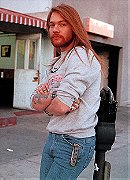
 6.9
6.9
 0
0

